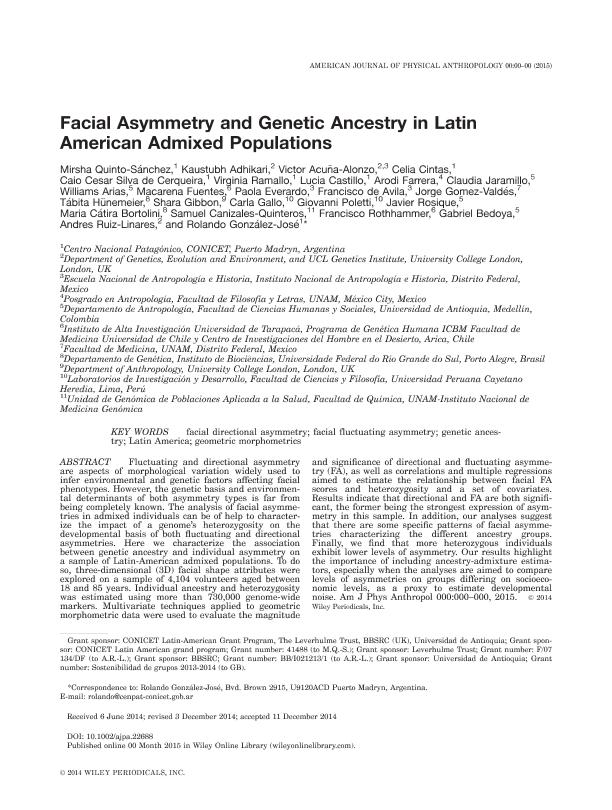Artículo
Facial asymmetry and genetic ancestry in Latin American admixed populations
Quinto Sanchez, Mirsha Emmanuel ; Adhikari, Kaustubh; Acuña Alonzo, Victor; Cintas, Celia
; Adhikari, Kaustubh; Acuña Alonzo, Victor; Cintas, Celia ; Silva de Cerqueira, Caio Cesar
; Silva de Cerqueira, Caio Cesar ; Ramallo, Virginia
; Ramallo, Virginia ; Castillo, Lucía Daniela
; Castillo, Lucía Daniela ; Farrera, Arodi; Jaramillo, Claudia; Williams Arias; Fuentes, Macarena; Everardo, Paola; de Avila, Francisco; Gomez Valdés, Jorge; Hünemeier, Tábita; Gibbon, Shara; Gallo, Carla; Poletti, Giovanni; Rosique, Javier; Bortolini, Maria Cátira; Canizales Quinteros, Samuel; Rothhammer, Francisco; Bedoya, Gabriel; Ruiz Linares, Andres; Gonzalez Jose, Rolando
; Farrera, Arodi; Jaramillo, Claudia; Williams Arias; Fuentes, Macarena; Everardo, Paola; de Avila, Francisco; Gomez Valdés, Jorge; Hünemeier, Tábita; Gibbon, Shara; Gallo, Carla; Poletti, Giovanni; Rosique, Javier; Bortolini, Maria Cátira; Canizales Quinteros, Samuel; Rothhammer, Francisco; Bedoya, Gabriel; Ruiz Linares, Andres; Gonzalez Jose, Rolando
 ; Adhikari, Kaustubh; Acuña Alonzo, Victor; Cintas, Celia
; Adhikari, Kaustubh; Acuña Alonzo, Victor; Cintas, Celia ; Silva de Cerqueira, Caio Cesar
; Silva de Cerqueira, Caio Cesar ; Ramallo, Virginia
; Ramallo, Virginia ; Castillo, Lucía Daniela
; Castillo, Lucía Daniela ; Farrera, Arodi; Jaramillo, Claudia; Williams Arias; Fuentes, Macarena; Everardo, Paola; de Avila, Francisco; Gomez Valdés, Jorge; Hünemeier, Tábita; Gibbon, Shara; Gallo, Carla; Poletti, Giovanni; Rosique, Javier; Bortolini, Maria Cátira; Canizales Quinteros, Samuel; Rothhammer, Francisco; Bedoya, Gabriel; Ruiz Linares, Andres; Gonzalez Jose, Rolando
; Farrera, Arodi; Jaramillo, Claudia; Williams Arias; Fuentes, Macarena; Everardo, Paola; de Avila, Francisco; Gomez Valdés, Jorge; Hünemeier, Tábita; Gibbon, Shara; Gallo, Carla; Poletti, Giovanni; Rosique, Javier; Bortolini, Maria Cátira; Canizales Quinteros, Samuel; Rothhammer, Francisco; Bedoya, Gabriel; Ruiz Linares, Andres; Gonzalez Jose, Rolando
Fecha de publicación:
12/01/2015
Editorial:
Wiley
Revista:
American Journal Of Physical Anthropology
ISSN:
0002-9483
Idioma:
Inglés
Tipo de recurso:
Artículo publicado
Clasificación temática:
Resumen
Fluctuating and directional asymmetry are aspects of morphological variation widely used to infer environmental and genetic factors affecting facial phenotypes. However, the genetic basis and environmental determinants of both asymmetry types is far from being completely known. The analysis of facial asymmetries in admixed individuals can be of help to characterize the impact of a genome's heterozygosity on the developmental basis of both fluctuating and directional asymmetries. Here we characterize the association between genetic ancestry and individual asymmetry on a sample of Latin-American admixed populations. To do so, three-dimensional (3D) facial shape attributes were explored on a sample of 4,104 volunteers aged between 18 and 85 years. Individual ancestry and heterozygosity was estimated using more than 730,000 genome-wide markers. Multivariate techniques applied to geometric morphometric data were used to evaluate the magnitude and significance of directional and fluctuating asymmetry (FA), as well as correlations and multiple regressions aimed to estimate the relationship between facial FA scores and heterozygosity and a set of covariates. Results indicate that directional and FA are both significant, the former being the strongest expression of asymmetry in this sample. In addition, our analyses suggest that there are some specific patterns of facial asymmetries characterizing the different ancestry groups. Finally, we find that more heterozygous individuals exhibit lower levels of asymmetry. Our results highlight the importance of including ancestry-admixture estimators, especially when the analyses are aimed to compare levels of asymmetries on groups differing on socioeconomic levels, as a proxy to estimate developmental noise.
Archivos asociados
Licencia
Identificadores
Colecciones
Articulos(CCT-CENPAT)
Articulos de CTRO.CIENTIFICO TECNOL.CONICET - CENPAT
Articulos de CTRO.CIENTIFICO TECNOL.CONICET - CENPAT
Citación
Quinto Sanchez, Mirsha Emmanuel; Adhikari, Kaustubh; Acuña Alonzo, Victor; Cintas, Celia; Silva de Cerqueira, Caio Cesar; et al.; Facial asymmetry and genetic ancestry in Latin American admixed populations; Wiley; American Journal Of Physical Anthropology; 157; 1; 12-1-2015; 58-70
Compartir
Altmétricas



